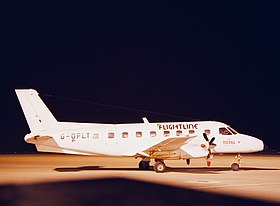Nordeste Linhas Aéreas Flight 115
| Nordeste Linhas Aéreas Flight 115 | |
|---|---|
|
Identical aircraft from Flightline |
|
| Accident summary | |
| Accident type | Loss of control after engine failure |
| place |
Recife , Brazil |
| date | November 11, 1991 |
| Fatalities | 15th |
| Survivors | 0 |
| Fatalities on the ground | 2 |
| Aircraft | |
| Aircraft type |
|
| operator |
Nordeste Linhas Aéreas , Brazil |
| Mark | PT-SCU |
| Departure airport |
Recife Airport , Brazil |
| Destination airport |
Salvador Airport , Brazil |
| Passengers | 12 |
| crew | 3 |
| Lists of aviation accidents | |
On November 11, 1991, an Embraer EMB 110 crashed on the domestic scheduled flight Nordeste-Linhas-Aéreas flight 115 from Recife to Salvador , with all 15 occupants and 2 people dying on the ground.
plane
The aircraft concerned was an 11 year-old Embraer EMB-110P1 Bandeirante ( air vehicle registration number : PT-SCU, plant number : 110314) with 2 turboprop engines of the type Pratt & Whitney Canada PT6A-34 was equipped.
course
While the EMB 110 was accelerating on the runway, the right engine was damaged unchecked, whereupon a fire broke out. Take-off continued anyway and the aircraft rotated at 900 m instead of the usual 570 m. It rose slowly and there was another bang, whereupon parts of the burning engine detached, fell and set a small area in the fenced-in airport area on fire. The aircraft reached a height of 30 m and then yawed to the right. Then it hit 2 houses, smashed at 9:43 p.m., 30 s after take-off, in a public square and then exploded.
Accident investigation
The investigation of the accident was made more difficult by the fact that the aircraft had no flight recorders.
During the investigations it was found that in the right engine a busbar of a sensor, which was responsible for the temperature display, was inadequately secured and insulated, as a result of which parts of the insulation came loose. On the one hand, this had the consequence that the displayed temperature was too low and, on the other hand, the cooling holes of the so-called CT-Vane-Ring, on which the compressor turbine was attached, blocked . Because of this, the right engine worked for a while at an elevated temperature. In addition, due to incorrect melting, the blades had wall thicknesses which differed from those in the design. These factors caused the ring to crack over time and ultimately to damage the engine when it failed.
According to the investigation, the pilots could and should have canceled the start. It could not be confirmed due to the missing flight recorder, but the rudder may have been trimmed in the wrong direction (that of the failed engine). This would have happened either before takeoff or after the engine failed. In any case, simulator flights at Embraer showed that with the correct trim a flat climb would have been possible, but with the wrong trim no further flight was possible. The night could also have had a negative impact on the behavior of the pilots, which is why they continued take-off.
Several serious shortcomings were found with the airline. It had no training program and did not have the pilots trained on the flight simulator, which would have prepared them for emergencies. The trainer was on the same level of knowledge as the trainees. The maintenance was also inadequate, with a total of 3 “Hot Section Inspections” (HSI) on the right engine of the crashed aircraft. The cracks on the CT vane ring were found in all of them. The maintenance manual stated that the entire blading would have to be replaced if the material was worn at a certain level . Despite the cracks and an operating time of 1,250 hours, the ring was not replaced and approved for a further 1,250 hours of use. The maintenance inspector neither supervised nor checked this procedural deviation. The maintenance engineer only gave a signature for the 1st and 3rd HSI, while the inspector did not have any signature for any HSI. The airline had not properly monitored all of this either.
recommendations
As a result of the accident, 4 recommendations were made to Nordeste Linhas Aéreas. Among other things, it should provide flight simulators to prepare for emergencies and emphasize the importance of the briefing for normal operations and emergencies. Another 7 were distributed to the relevant aviation authority. Among other things, it should make flight simulators compulsory for airlines and create clear deadlines for them in which they must meet minimum safety requirements for training and maintenance. She should also recommend both the airlines and the maintenance workers to check the insulation of the busbar during maintenance and, if necessary, to inspect the cooling holes for blockages caused by detached parts.
swell
- Flight accident data and report PT-SCU in the Aviation Safety Network (English), accessed on July 30, 2019.
- Description of the accident on desastresaeros.com (Portuguese) , accessed July 30, 2019
